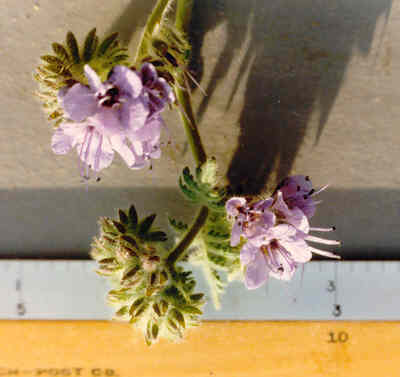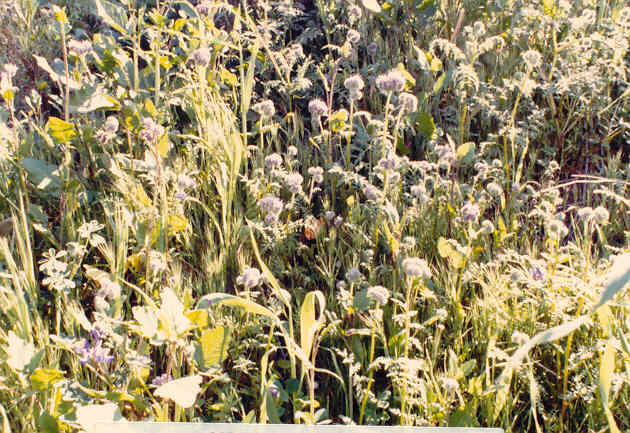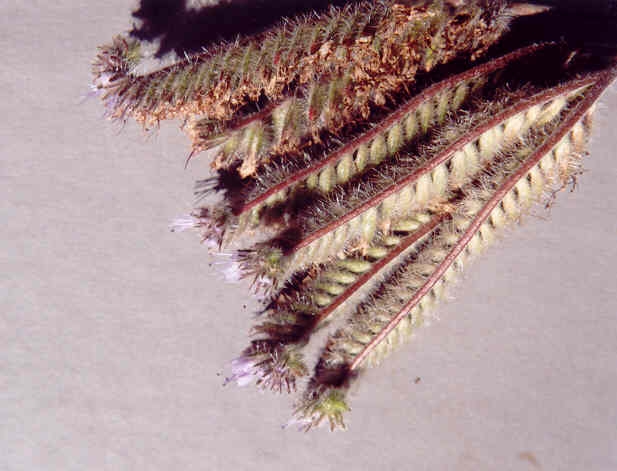
Phacelia tanacetifolia Benth.
 |
Phacelia tanacetifolia Benth.
Hydrophyllaceae (Waterleaf Family)NativeTansy Phacelia |
March Photo
Plant Characteristics:
Annual, 15-100 cm. high, resembling P.
distans, glandular-puberulent and hirsute throughout, often stouter; lvs.
20-200 mm., blades longer than petioles, +/- oblong to ovate, generally
compound, lfts. toothed to lobed; fls. many,
short-pedicelled in prominent compact cymes; calyx-lobes mostly linear 6-8 mm.
long, densely pubescent and hispid; corolla blue, broadly campanulate, 6-9 mm.
long, quite persistent; scales usually completely adnate; stamens 1.5-2 times as
long as corolla; style glabrous, deeply cleft; caps. 3-4 mm. long, pubescent;
seeds usually 2, coarsely pitted in transverse rows.
Habitat:
Open flats and slopes below 4000 ft.; many Plant Communities, n. L.
Calif. to Lake and Butte cos., up to 6000 Ft. in Mojave Desert; Santa Cruz Id.;
to Nev., Ariz. March-May.
Name:
Greek, phakelos, a cluster,
because of crowded fls. (Munz, Flora So. Calif. 502).
LL. tenacetum, a name for
tansy. Ex. tanacetifolia. (Jaeger
259). Latin, folium, leaf. (Simpson
252).
General:
Rare in the study area in the sense that it has only been found in one
place, however, each year there is a large stand on the bluffs just northerly of
the Newporter Inn. In 1998, a wet
year, the bank above Back Bay Dr. slipped at the location of this species.
The seed base was either buried or carried across Back Bay Dr. and later
hauled away. I found no P.
tanacetifolia plants in the spring of 1999 or 2000; however in 2001, I found
a few plants along the edge of the slide. (my comments).
The plant may be cooked as greens. (Kirk
74). All of
the Phacelias are native to the New World.
Authorities claim 87 of them for California. (Dale 125).
Annuals make up the most diverse component of the chaparral flora.
They are most abundant in disturbed areas and flower in the first spring
after a fire. Some of these
species, such as Phacelia species, Emmenanthe
penduliflora, and Papaver californicum,
have been referred to as "fire annuals" or "pyrophyte
endemics" because they may dominate a site in the first year after a fire
and then disappear until the next fire. These
species have seeds that lie dormant in the soil until germination is stimulated
by fire. Although longevity of
these seeds has not been well studied, circumstantial evidence suggests that
they may be long-lived, perhaps one hundred years or more. Other native annuals are quite opportunistic in that they are
most abundant on burned sites but persist within gaps in the chaparral canopy.
Examples of these include species of Cryptantha,
Plagiobothrys, Amsinckia, Cammissonia and Lotus.
Some of these have polymorphic seed pools where a portion of the seeds
germinate readily in the absence of fire and others require fire stimulation for
germination. One explanation of the
striking contrast between the depauperate herb growth under mature chaparral and
the flush of herbs after a fire may be the suppression of germination by a toxin leached from the overstory shrub foliage.
While this
theory of
"allelopathy" has gained widespread notoriety and is often discussed
in college textbooks, there is good reason to question its significance in
chaparral. Field studies have shown that seedlings that do establish
under the chaparral canopy are readily consumed by small animals.
This predation pressure, coupled with poor conditions of low light,
limited water, and insufficient nutrients under the shrub canopy, has more
likely resulted in evolutionary selection of herbs with seeds that remain
dormant until after fire. (Keeley,
Jon E. and Sterling C. "Chaparral
and Wildfires" FREMONTIA,
A Journal of the California Native Plant Society.
October 1986 pp. 19-20). For
additional information on plants and fires see Bloomeria
crocea, Eriophyllum confertiflorum,
Lolium multiflorum and Salvia
columbariae. Perhaps
200 species of New World, especially in w. N. Am., some of horticultural value. (Munz, Flora So. Calif.
502).
Text Ref:
Abrams, Vol. III 493; Dale 127; Hickman, Ed. 705; Munz, Flora So. Calif. 516; Roberts 26.
Photo Ref:
March 1 85 # 14A,15A; April 2 87 # 19A,20A; May-June 01 #3A.
Identity: by R. De Ruff,
confirmed by F. Roberts.
First Found: March 1985.
Computer Ref: Plant Data 62.
Have plant specimen.
Last edit 12/26/04.
 |
 |
April Photo May Photo